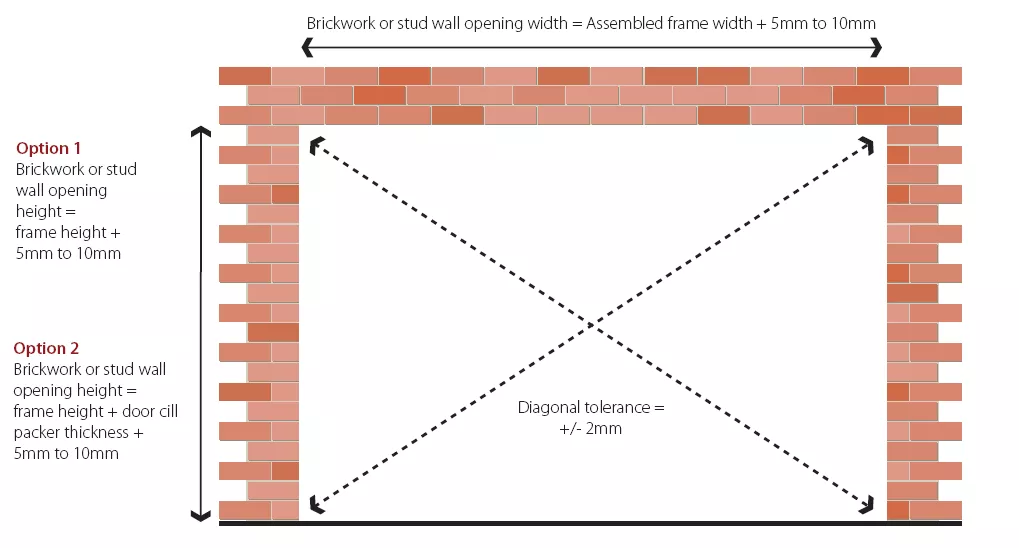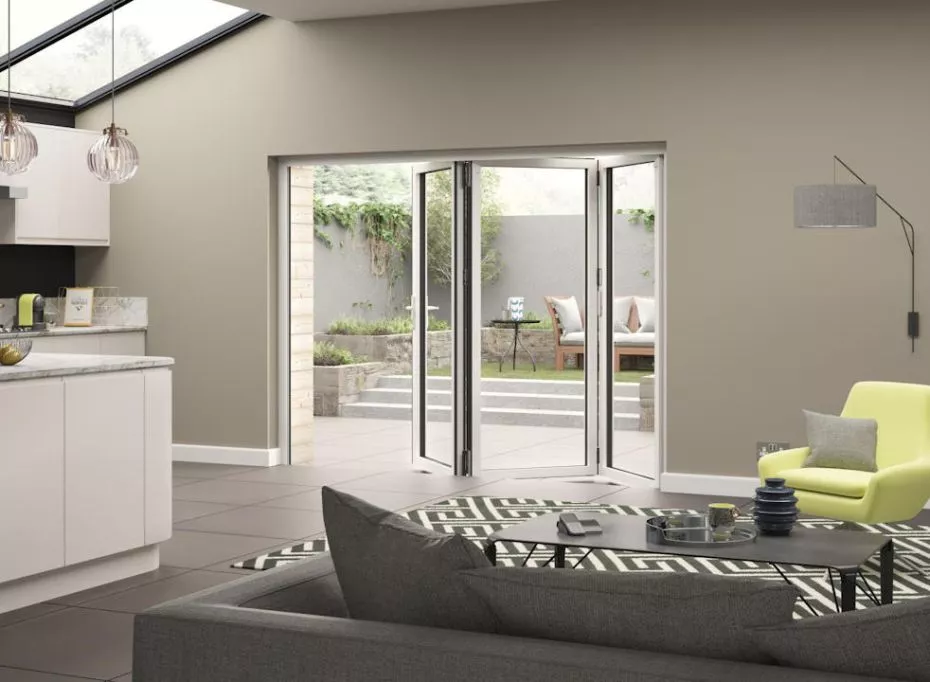How to replace a door with DIY bifolds & when to replace your door
Have you noticed your patio doors have become damaged or worn over time? Or, are you simply looking to give your home a makeover and invest in new door designs?
Replacing your doors with bifold doors can be done by anyone with moderate DIY knowledge, thanks to ready-to-assemble doors. In this guide, you will find out more about replacement bifold doors, including preparation and installation advice.
In this guide:
Read the key benefits of choosing a replacement door.
Find out more about the benefits of bifold doors in comparison to other patio doors.
Find out what ready-to-assemble doors are and their benefits.
Read how you can prepare for a replacement door to be fitted.
Find out how to correctly install a replacement door.
We answer common questions on replacing bifold doors.
What are the benefits of choosing a replacement door?
The main benefit of choosing a replacement door is ease. The masonry work has already been done when the old door was installed. The necessary space exists; it is simply a case of replacing the actual door.
With ready-to-assemble doors, this process is made simple due to easy installation, clear instructions and pre-machined parts. This means replacement door installation can be done by anyone with some DIY knowledge. You can find out more about ready-to-assemble doors below.
What types of doors can be replaced?
There are three main types of external door that can be replaced with a new bifold door:
-
Bifold doors (old)
-
French doors
-
Sliding doors.
These doors can often require similar dimensions and sizes, meaning they can be interchangeable. For example, you may wish to replace your old French doors with a set of new bifold doors. You will need to measure beforehand to ensure you purchase the right size doors.
The interchangeability of these external doors means the following locations could be improved by replacement doors:
-
Kitchen. Find out more about the kitchen bifold doors.
-
Patio
-
Summer houses. Read more about using bifold doors in summer houses here.
How do bifold doors compare with sliding doors and French doors?
If you’re looking for a door that will maximise the view from your home, bifold doors are the best option. There is a wide range of materials available so it’s easy to find a door that meets your needs and preferences. When using bifold doors, you have the option of opening the entire door for maximum impact, or simply using the traffic door for normal usage.
Sliding doors also provide excellent views, and offer easy operation. They simply move along a track and stack on top of each other. If you are working with limited space, then sliding doors can be beneficial because they won’t take up any additional room like bifold doors do; they simply slide horizontally down the track. With very wide panes of glass, they make the most of the natural light. However, although they still provide an excellent view - due to the operation of sliders, some must have a static glass panel that the operational pane sits on top of. This means you cannot fully open the space. Both sliding doors and bifold doors offer a modern, sleek appearance.
On the other hand, if you’re looking for a more traditional style and an easy operating system, French doors may be the most ideal option. This simplicity of a French door also carries lower costs too so, if you’re on a lower budget, French doors can be an attractive option. However, although they offer better views than a single door; the view is nowhere near as expansive as bifold or sliding doors.
Read our full comparison of the different types of patio doors here.
What are ready to assemble bifold doors and why choose one?
Ready-to-assemble bifold doors offer a completely new, innovative way to install your doors. With a ready-to-assemble bifold, you could be ready to replace your old door from the moment of arrival.
Within the package includes:
-
The bifold door parts including frame and glass
-
All hardware required for installation (including drill bits and fittings)
-
Most tools for installation
-
Clear and concise instructions.
The assembling process is designed to be as easy as possible, with clear instructions dictating the proper process.
Ready-to-assemble doors are designed to be quick and simple, meaning that competent DIYers can install the doors on-site themselves without having to pay for a professional.
Benefits of ready-to-assemble doors
-
Easy installation
-
Clear and informative instructions
-
High-quality pre-machined materials
-
All hardware included
-
Most tools included
-
No specialist equipment required
-
No hidden costs
-
Assured quality with every part tested comprehensively.
Standard bifold doors require a trained professional tradesman for installation. This is because their installation processes can be complicated. They can take over two days to install.
Vufold’s ready-to-assemble door sets are designed to be as simple as possible. A competent DIYer can install the RTA doors within a day.
For both types of doors, two people may be required for installation. This is due to the doors being heavy, which one person may find difficult to manoeuvre.
Best oak external bifold doors: Elite

The Vufold oak bifold doors range boasts strength, durability and reliability, as well as the slimmest door stiles on the market, with a greater glass area for better views. A combination of stunning aesthetics and finger-tip operation cements the Elite as one of the best external bifold doors available.
Elite doors are prefinished with three coats of microporous factory-applied finish for maximum UV protection. The glass is double-glazed toughened tempered safety glass for excellent thermal efficiency.
From £1819
How to prepare for a replacement door
There are certain steps you can take to ensure the smoothest possible replacement processes. These steps can be made before installation to save time. These steps include:
-
Removing the previous door
-
Measuring the opening
-
Sourcing the required tools
-
Interior/exterior considerations.
Removing the previous door
Removing the previous door is probably the most complex step to take. It may not be immediately apparent how to uninstall the door. You may be able to find the installation guide for your old bifolding doors online. Alternatively, you could contact your previous supplier for additional help.
If your old bifold door is plastered in the location, you will need to plan accordingly to reduce any damage to the plasterwork.
Measuring the opening
You need to measure the opening before purchasing any replacement bifold doors accurately. Even if you measured before installing your old doors, it is worth remeasuring to ensure an accurate result.
Measuring the opening requires four simple steps:
-
Measure the width in three separate levels (bottom, middle, top)
-
Measure the height from top to bottom at three separate places (left, centre, right)
-
Subtract 5mm - 10mm from the smallest measurements (to ensure enough space to fit the bifold and the frame)
-
Check that the aperture is a perfect square by measuring the diagonals from corner to corner.

What tools are required?
The required tools depend on the type of door you are installing. Standard bifold doors may require specialised tools such as routers and chisels. These can be hard to source and difficult to use, requiring a professional.
Ready-to-assemble doors come with almost all the tools required for installation. The only few tools you need to source are readily available at most DIY stores (or even in your home!).
REQUIRED TOOLS: READY-TO-ASSEMBLE BIFOLD DOORS VS STANDARD BIFOLD DOORS
|
Ready-to-assemble bifolds |
Standard bifolds |
|
|
Exterior doors need to be fully weather sealed to ensure that optimum insulation. This ensures you don’t waste energy heating or cooling your home. It also means no unpleasant drafts or weather damage. The type of glazing should also be considered. Vufold recommends purchasing bifold doors with double glazing glass. The double glazing will help improve insulation and energy efficiency.
You can find more information by visiting our guide – External bifold door locations: patio, kitchen, extensions and summer houses
Shop our full range of external bifold doors here.
Are you looking for a white aluminium bifold door?
Our pick:
Shop our Supreme aluminium bifold doors
From £1,819

- 15 Year guarantee
- Integrated, weather rated low threshold & cill
- Energy rating C
- Double and triple glazing.
How to install Vufold’s ready-to-assemble doors
Each door has its own set of specific instructions that need to be followed for correct installation. However, ready-to-assemble doors generally follow four easy steps for installation:
-
Assemble the frame
-
Fix the frame into the brickwork opening, square up and level
-
Fix the hardware to the doors and fix the doors to each other
-
Adjust height and width if needed.
All these steps are straight forward and clearly explained in your bifold’s instruction manual. If you want to know more about Vufold’s ready-to-assemble doors during quarantine, visit our guide - Ready-to-Assemble Doors: the DIY bifolds for self-installation
Can you put new doors in old frames?
Each type of bifolding door uses a specific style of operation, which in turn require specific frames for operation. This means that it is not as simple as replacing new doors in old frames. You should always remove your old frames before installing new replacement bifold doors.
Are you looking for a new, eye-catching bifold door? Shop our range of bifold doors here.
Frequently asked questions
Should my doors open inwards or outwards?
Most people choose to have open out bifold doors for two main reasons, firstly if it’s been raining and the doors are wet on the outside they won’t drip onto your flooring when open.
Secondly, there is no issues with furniture getting in the way of the doors when they concertina open or closed.
Vufold standard size bifold doors all open out. If you do need open in we can manufacture these in our Status and Supreme aluminium bi fold door ranges as a bespoke order.
How long does it take to fit a new door?
The amount of time it takes to fit a new bifold door depends on a few factors:
-
Level of experience of the installer
-
Type of bifold door
-
Amount of people installing.
Where can bifold doors be used?
External bifold doors can be used in many different locations. The most common use is in new extensions added to the rear of a house. This could be an extension to the kitchen, living or dining room. They are also often found in conservatories, orangeries, bedrooms and are now widely used in garden rooms also.
Visit our case studies or customer gallery for further idea's on where you can use bifold doors.
How secure are external bifold doors?
Modern bifold doors come with a host of security features making them very secure especially when compared with older style sliding patio or French doors that just feature a single locking point.
Bifold door hardware and track systems combined with the numerous locking points generally make it impossible to simply lift the doors out of the frame.
Are bifold doors energy efficient?
Yes, modern bifold doors are highly energy-efficient when they feature double or triple glazing and thermal breaks within the frames. These features help retain heat and reduce energy bills.
How long do bifold doors last?
High-quality aluminium bifold doors can last 20-30 years or longer with proper maintenance. UPVC doors typically have a shorter lifespan of around 15-20 years.
RELATED CONTENT

About Martin Burgess
For customers, Martin is one of the key people at Vufold and looks to offer technical advice, resolve any issues or problems that they may have. Martin is passionate about protecting the reputation of Vufold and likes to see a positive impact on the business due to his day-to-day efforts. Martin’s proud of the team he’s built around him and is dedicated to constantly improving the way the company meets its service commitments and delivers on its promises.
Read more about Martin Burgess

